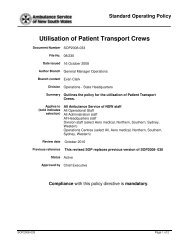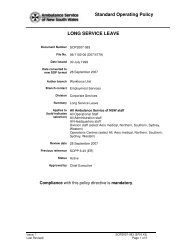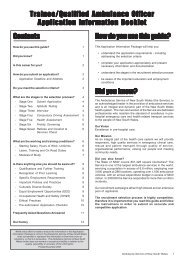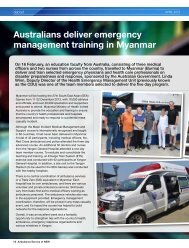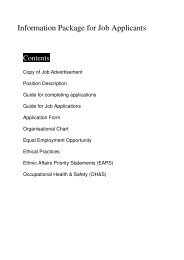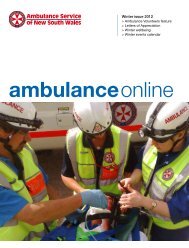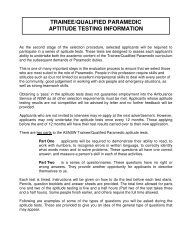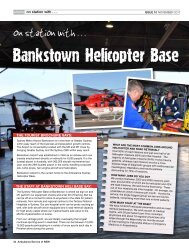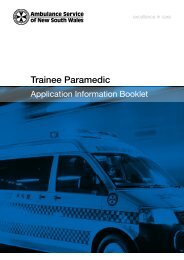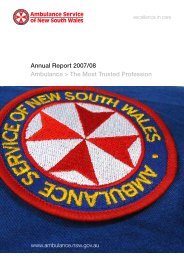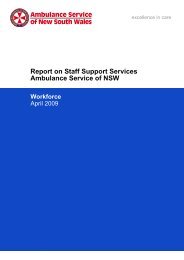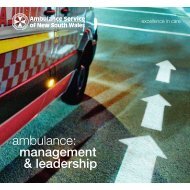atsb final report released 16 may 2013 - Ambulance Service of NSW
atsb final report released 16 may 2013 - Ambulance Service of NSW
atsb final report released 16 may 2013 - Ambulance Service of NSW
You also want an ePaper? Increase the reach of your titles
YUMPU automatically turns print PDFs into web optimized ePapers that Google loves.
specifications). The pilot <strong>report</strong>ed that when he turned on the searchlights it was notyet dark enough to see their beams and, as there was no cockpit indication <strong>of</strong> theposition <strong>of</strong> the lights, he positioned the secondary searchlight to illuminate what heassessed was the right side <strong>of</strong> the helicopter (the pilot, winch and winching positionwere located on the right <strong>of</strong> the aircraft). The pilot <strong>report</strong>ed that the secondarysearchlight’s position remained unaltered after initial positioning, as selecting theswitches to reposition it would have resulted in the Nightsun extinguishing. TheACM <strong>report</strong>ed attaching a chemical light stick to the winch hook for ease <strong>of</strong>identification and requested that the pilot activate the winch-mounted lights toilluminate the area below the helicopter winch.The multi-purpose flight recorder (MPFR) 10 showed that at 2020, the flight crewreceived a radio call from the duty paramedic advising that he and the patient were‘…ready for an accompanied stre [sic].., ah, accompanied hypo strop lift withequipment…’. The pilot asked the ACM to respond to the paramedic, but therecorded audio showed that the intended outgoing message was only transmittedover the helicopter’s internal communication system (ICS) (see the section titledRadio communication system).The pilot then responded to the duty paramedic and advised that the helicopter hadbeen refuelled and that they were about 1 minute from the waterfall. The paramedicreiterated that he was ready for an accompanied hypo strop lift and that ‘...the tagline will be set by me...’ (see the section titled Role equipment). He also advisedthat he had been unable to securely stow the canyoners’ rope and that, as such, it<strong>may</strong> present a hazard to the tag line during the retrieval.The attempted recoveryAbout 2 minutes, later the pilot commenced an approach to overhead the supportparamedic’s position in order for this paramedic to connect the tag line to thehelicopter’s winch hook. During the helicopter’s approach, the support paramedicactivated a strobe to assist the identification <strong>of</strong> his position. Approaching overheadthe top <strong>of</strong> the waterfall, the pilot called ‘losing sight’ 11 at 2022 and the ACMcommenced providing verbal guidance to allow the pilot to manoeuvre thehelicopter towards the support paramedic’s position. Once the pilot established thehover, the ACM lowered the winch hook to the support paramedic who attached hisend <strong>of</strong> the tag line to the hook and then let go <strong>of</strong> the hook.The support paramedic advised that, when he connected the tag line to the winchhook, he bypassed the installed weak link (see the section titled Role equipment andFigure 21) by connecting the hook directly to the tag line, rather than physicallyremoving the weak link. He stated that the weak link was bypassed afterconsidering the potential forces associated with the duty paramedic retrieving thewinch hook or in the event that the tag line was used as a stabilising system.Although it was required by the operator’s procedures, the support paramedic1011The multi-purpose flight recorder, commonly known as a ‘black box’ flight recorder, recordedcertain flight parameters and ambient noises within the cockpit, including radio transmissions andconversation between the crew.This statement indicated that the pilot had lost sight <strong>of</strong> the winching area is a signal to the ACM tocommence providing verbal guidance to assist the pilot to position the helicopter overhead thewinching area. Given the relative position <strong>of</strong> the pilot to the helicopter winch, this will alwaysoccur approaching overhead the winching area.- 7 -



